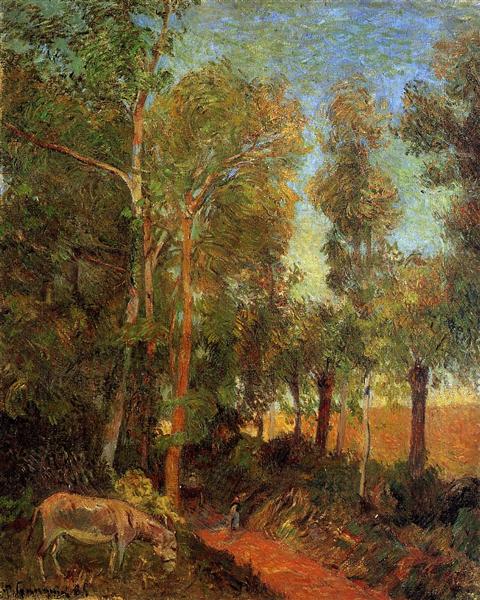Description
The painting "Burro by lane" (1885) by Paul Gauguin is a work that encapsulates the artist's interest in the representation of the rural world and his fusion of everyday life with a vibrant and evocative palette. In this piece, we observe the representation of a donkey that walks slowly along a rustic path, an image that might seem simple at first sight, but that when broken down is rich in details and nuances.
Gauguin, a member of the post -impressionist movement, is characterized by its bold color use and its focus on emotional expression through form. In "donkey by lane", the choice of colors is remarkable. Earth's tones predominate in the background, where a soft brown and green is mixed, suggesting a landscape that is both realistic and symbolic. The donkey, represented with a mixture of gray and black, stands out on the background, injecting a sense of tranquility to the scene and a palpable connection with the natural environment.
The composition of the work is direct, focused on the animal, which seems to occupy both physical and emotional space. The path of the path provides a visual guide to the viewer, leading it to follow the way of the donkey. This line not only connects the foreground with the background, but also suggests a trip, a subtle narrative that invites the viewer to reflect on rural life and man's relationship with nature. The way in which the donkey moves through the lane evokes a contemplative calm, a moment that can be seen as an echo of rural life in the France of the late nineteenth century.
It is interesting to observe that this piece belongs to a period in which Gauguin began to explore a greater simplification of shapes and greater expression through color. Although the donkey is the only "character" present in the work, its representation talking about rural life suggests a connection with human beings who inhabit that space, highlighting an interrelation that goes beyond the simple representation of an animal. In this sense, painting can be interpreted as a meditation on simple life and the simple pleasures it offers.
The work takes place in a context in which Gauguin moved away from the conventions of impressionism, looking for more forceful forms of expression. In his series of works, the artist often portrays the reality in which he is, but chooses to do it through a particular prism that alters the spectator's perception. "Donkey by lane" is an example of this exploration, where the simplicity of the scene becomes a reflection of the complexities of human nature and its environment.
Finally, although it is not as well known as his subsequent works in Tahiti, "Donkey by lane" represents a crucial moment in the development of Gauguin's artistic language. The work combines the precise observation of nature with an incipient search for deeper ideas about the existence and relationship of man with his environment. As the viewer stops to consider every detail of this painting, He meets the quiet but penetrating voice of an artist who moves in a personal and artistic exploration path.
KUADROS ©, a famous paint on your wall.
Hand-made oil painting reproductions, with the quality of professional artists and the distinctive seal of KUADROS ©.
Reproduction service paintings With a guarantee of satisfaction. If you are not completely satisfied with the replica of your painting, we refund your money 100%.

